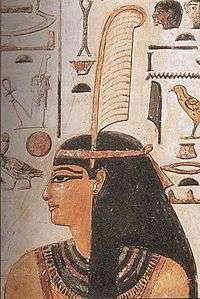mꜣꜥt
Egyptian

The goddess
, personification of truth and right
Etymology
An abstract noun formed from mꜣꜥ (“to direct, to be just, to be true”) + -t (“feminine ending”).
Pronunciation
- (reconstructed) IPA(key): /ˈmuʀʕat/ → /ˈmuʀʕaʔ/ → /ˈmuʔʕəʔ/ → /ˈmøʔʕə/[1]
- (modern Egyptological) IPA(key): /mɑʔɑːt/
- Conventional anglicization: maat
Noun
f
Inflection
Declension of mꜣꜥt (feminine)
| singular | mꜣꜥt |
|---|---|
| dual | mꜣꜥtj |
| plural | mꜣꜥwt |
Alternative forms
Alternative hieroglyphic writings of mꜣꜥt
| mꜣꜥt | mꜣꜥt | mꜣꜥt |
Descendants
Derived terms
References
- Erman, Adolf; Grapow, Hermann (1926–1961) Wörterbuch der ägyptischen Sprache, Berlin: Akademie-Verlag, ISBN 3050022647
- James P[eter] Allen (2010) Middle Egyptian: An Introduction to the Language and Culture of Hieroglyphs, 2nd edition, Cambridge: Cambridge University Press, ISBN 978-0-521-51796-6.
- Hoch, James (1997) Middle Egyptian Grammar, Mississauga: Benben Publications, ISBN 0920168124, page 112
- Loprieno, Antonio (1995) Ancient Egyptian: A Linguistic Introduction, Cambridge: Cambridge University Press, ISBN 0-521-44384-9, page 39, 47
This article is issued from
Wiktionary.
The text is licensed under Creative
Commons - Attribution - Sharealike.
Additional terms may apply for the media files.